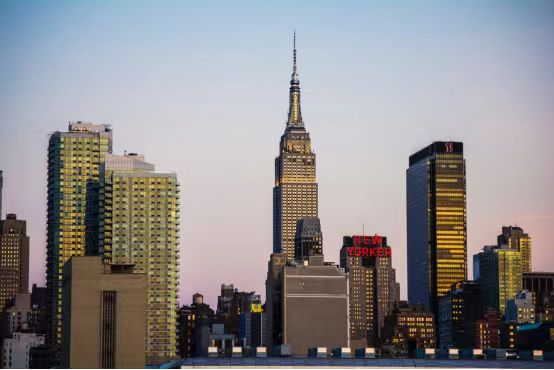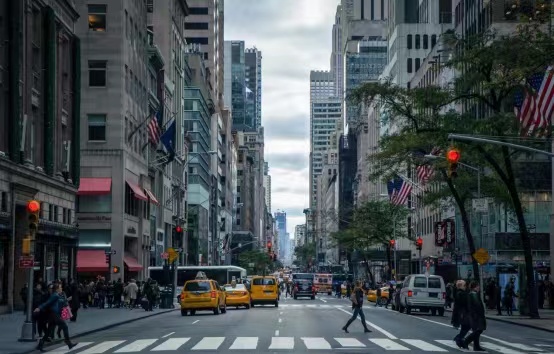
1. Introduction
New York is located on the southeast coast of New York State, USA, along the Atlantic Ocean. It is the largest city and the largest port in the United States, a global financial and cultural center as well. New York covers an area of 1,214 square kilometers with a population of approximately 8.4 million. The New York Bay Area spans 34,500 square kilometers and has a population of 22.68 million, with a GDP exceeding 2 trillion U.S. dollars. According to the 2019 Innovation Cities Index published by the Australian innovation data analysis company 2THINKNOW, New York ranks first. New York is also the location of the United Nations headquarters and home to a large number of international organizations. Every year, there are around 80 to 90 large international conferences, maintaining an extremely far-reaching and extensive international influence. The key industries in New York are finance, technology, culture, and fashion. According to the Fortune magazine's released list of the Fortune Global 500 companies for the year 2020, a total of 15 companies are headquartered in New York, including JPMorgan Chase & Co., Citigroup Inc., Goldman Sachs Group, and American Express.
2. Overview of Innovation and Development
(1) Innovation Development Strategy
New York's economic industry breadth and depth far surpass other cities worldwide, with a strong consumer base. After the 2008 financial crisis, New York City's capital-driven economy, represented by Wall Street, took a suffering. At this turning point, New York's urban development showed a clear strategic shift, namely, a transition from a single capital-driven force to a dual-wheel drive transformation relying on financial capital and technological innovation. The proportion of the technology industry in New York City's GDP increased by 25% over a decade, generating an annual tax revenue of 5.6 billion U.S. dollars. Thanks to its comprehensive strength, New York currently possesses the world's second-largest startup ecosystem (second only to Silicon Valley), with over 9,000 startups. The technology industry is the fastest-growing and highest-income industry in New York, providing 291,000 jobs per year and 30 billion U.S. dollars in annual wages, second only to the financial industry. New York has gradually evolved into a true center of technological innovation by creating an iteratively upgraded innovation industry ecosystem.

Photo by jesús mirón garcía on pexels
(2) Key Support Measures
The Regional Plan Association (RPA) of New York successively carried out four regionally planned strategies with different emphases, becoming a vital fulcrum for enhancing the economic and technological competitiveness of the New York Bay Area, with profound impact. In recent years, New York City has successively introduced a series of targeted policy measures such as the "NYC Talent Draft," "NYC Tech Talent Pipeline," and "Applied Sciences NYC," aiming to cultivate technological innovation talents and enhance the deep-seated driving force for economic and social development. The government in the New York Bay Area has mainly taken the following measures to create a high-quality innovative ecosystem environment:
1. In terms of infrastructure, increase investment in the construction of urban infrastructure that adapts to the development of the innovation economy. With the rapid development of modern technology, the New York Bay Area continuously invests on a large scale in areas such as information infrastructure and the growth of technology companies, to better support the development of the innovation economy.
2. The government spares no effort in providing financial support to growing technology companies. Not only does New York have strong investment funds and technology-related industries, but also has governments at all levels providing necessary financial support for some industries and enterprises. For example, the New York City government currently has two major funds, the “NYC Seed Fund” and the “Partnership for NYC”, which can invest in companies in the seed or expansion stage in fields such as financial technology, medical health, network technology, and life sciences.
3. The government's fundamental goal is to achieve industrial upgrading, constructing a harmonious industry assistance system and a diversified innovation ecosystem. The rapidly rising entrepreneurial communities, ample funds and talents, and developed media constitute New York's unique charm in the innovation economy.

Photo by charles-parker on pexels
(3) Innovation Development Entities
A. Key Companies: New York is the birthplace of financial technology (FinTech) and banking law, It is home to the three major stock exchanges in the United States, including the New York Stock Exchange, NASDAQ and the American Stock Exchange. Wall Street is home to the headquarters of over 100 internationally renowned banks and insurance companies such as JPMorgan Chase and Goldman Sachs, laying the foundation for its position as the world's top financial center. In the past, it was finance investing in technology; now it is technology serving finance, applying new technologies such as big data, cloud computing, blockchain, and artificial intelligence to traditional finance, making financial services faster and more efficient. New York City is promoting the development of financial technology through projects such as “Startupbootcamp Fintech New York” and “Fintech Innovation Lab” (cooperatively operated by the New York City Partnership Fund and Accenture). As a global financial service center, New York has witnessed a new wave of investments as financial institutions continue to digitize. Over the past five years, the growth rate of New York's fintech industry has been twice that of Silicon Valley. In addition to financial services and financial technology, New York is also home to globally renowned companies in sectors such as telecommunications, fashion retail, and manufacturing. These companies have long been global leaders in their respective fields and have played an immeasurable leading role in driving technological innovation in their respective fields.
B. Science and Technology Parks: In this process, co-working spaces, an important carrier of technology innovation and entrepreneurship in New York, have flourished, nurturing a large number of small and medium-sized technology innovation startups, and becoming an important booster for the construction of a global science and technology innovation center in New York. For example, WeWork co-working space was born in New York and is the only unicorn among the five global technology unicorns not born in Silicon Valley. WeWork provides shared workspace and was founded by Adam Neumann and Miguel McKevley in 2010. So far, WeWork has raised $12.8 billion from investors such as SoftBank, Wellington, Benchmark, and Huayi Investment. The development strategy and measures of the New York City government for co-working spaces mainly include several aspects: the government jointly builds co-working spaces through public-private partnerships to attract a large number of social forces to follow up; incorporate co-working spaces into the city's public service facility system to guide the balanced layout of co-working spaces; promote the integration and sharing of co-working spaces with urban functional spaces to drive the organic renewal of New York City. New York's science and technology innovation industry is concentrated in the central urban areas, starting from the midtown south area, including the Flatiron District, Chelsea District, SOHO District, and Union Square, gradually spreading to downtown Manhattan and Brooklyn. This borderless science and technology industry cluster is known as "Silicon Alley." Currently, 14,500 startups are located in New York, with an estimated yearly valuation of 70 billion dollars. The major areas are artificial intelligence (AI), smart cities, and network security, which promote "high value," "low output," and "tailor-made" products, according to the New York City Economic Development Agency.

Photo by nout gons on pexels
C Institutions of Higher Learning: Higher education is well developed in New York City and surrounding cities. There are a total of 314 universities and colleges in New York State, with 64 located in New York City. Columbia University, Cornell University, New York University, and the University of Rochester are all highly ranked universities in the world university rankings. According to data from the New York State Statistics Bureau, approximately 2.4 million people in New York have a bachelor's degree or above, accounting for 29% of the total population, surpassing the sum of Boston, Philadelphia, San Francisco, Los Angeles, and Washington, D.C. The government is implementing a computer science popularization plan, with approximately 4,500 students graduating in computer science each year. "Cornell Tech" is a significant project of the New York government's technology development plan with applied science as its main focus, emphasizing assistance to major companies in solving practical problems.

